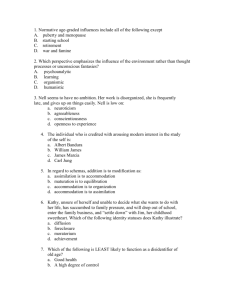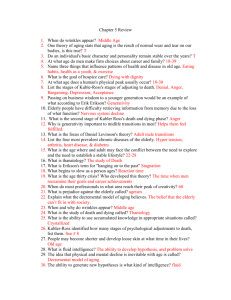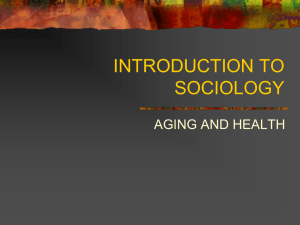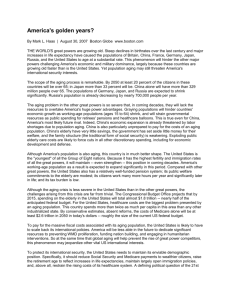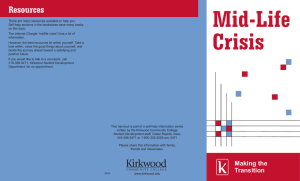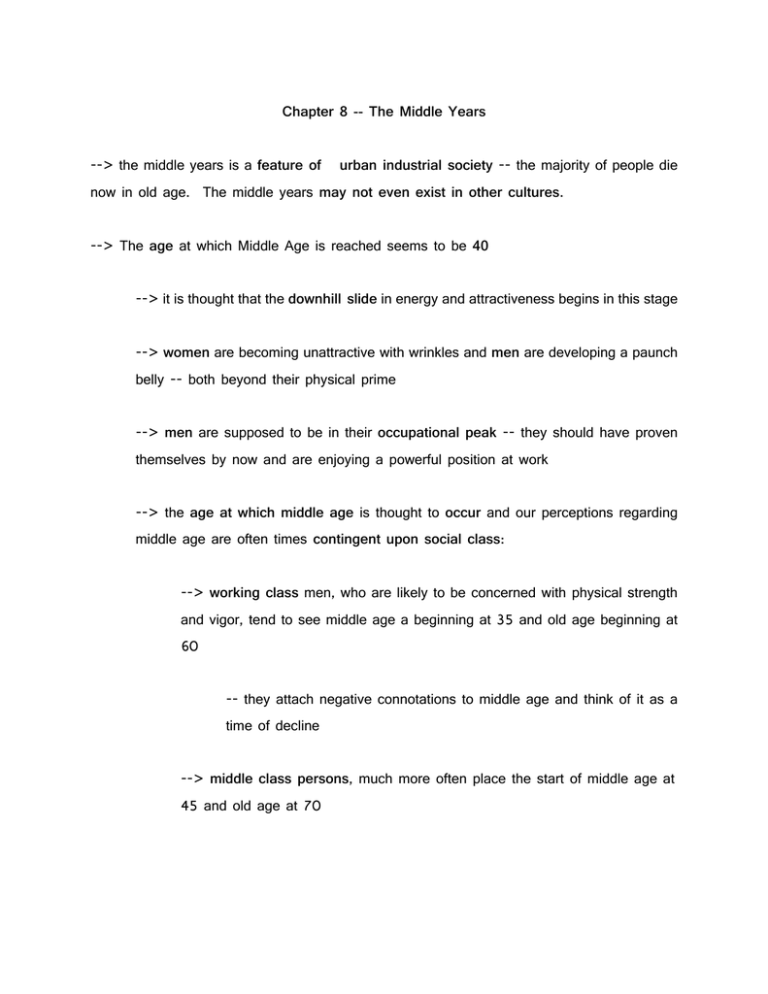
Chapter 8 -- The Middle Years
--> the middle years is a feature of
urban industrial society -- the majority of people die
now in old age. The middle years may not even exist in other cultures.
--> The age at which Middle Age is reached seems to be 40
--> it is thought that the downhill slide in energy and attractiveness begins in this stage
--> women are becoming unattractive with wrinkles and men are developing a paunch
belly -- both beyond their physical prime
--> men are supposed to be in their occupational peak -- they should have proven
themselves by now and are enjoying a powerful position at work
--> the age at which middle age is thought to occur and our perceptions regarding
middle age are often times contingent upon social class:
--> working class men, who are likely to be concerned with physical strength
and vigor, tend to see middle age a beginning at 35 and old age beginning at
60
-- they attach negative connotations to middle age and think of it as a
time of decline
--> middle class persons, much more often place the start of middle age at
45 and old age at 70
-- they generally have a more positive view of middle age and think of
it as a time of peak productivity and income.
There are two schools of thought about the stability of persons during the middle years:
--> One school of thought suggests that both men and women become more stable
in their middle years -- wiser and more accepting of life
--> however, the other school of thought suggests that this is a turbulent time -- a time
of Amid-life crisis@
The Mid-life Crisis Debate
Yes it exists ---> it is proposed that the reality and inevitability of one=s own death is the central
and crucial feature of the mid-life phase.
--> it is described as a restless time when one looks back over their accomplishments
and gets depressed that they haven=t accomplished all that they had hoped to.
--> this is why sudden career changes occur, spouse changes (divorce), or sudden
changes in other major commitments.
--> a time when role involvement decreases and so middle aged men and women
begin to feel useless or worthless or not as needed as they once were
-- studies of social networks suggest that in the middle years and beyond, social
activities generally diminish
-- with increasing age, social ties with kin tend to constitute a larger proportion
of meaningful relationships for both men and women, whereas young adults tend
to have more relationships with friends, neighbors, and colleagues
-- children become independent and less a source of immediate concern
-- Moen, Dempster-McClain, and Williams (1989) -- reading on reserve -- their
research suggests that the more involved/integrated women are, the longer they
live.
-- suggesting that with the decrease in roles in mid-life these women
could be affecting their life expectancy.
-- aging parents are likely to become more dependent on men and women in
their 40s and 50s thus perhaps creating a strain or burden on the middle agers.
--> Levinson=s theory of the life course offers an explanation for a mid-life
crisis:
-- he proposes a mid-life transition between the ages of about 40 and 45 and
states that it must begin no earlier than 38 and no later than 43
-- he sees three major tasks as needing to be accomplished during the
transition:
1. terminating the era of early adulthood with a review and reappraisal
of what has been done to date;
2. modifying the negative aspects of the present life structure and testing
new choices;
3. dealing with the polar issues of youth versus old age, destruction
versus creativity, masculinity vs. femininity, and attachment vs.
separation
-- according to Levinson, every man must come to term with these issues
-- what do you think of Levinson=s ideas?
Critique:
-- he gives no rationale as to why this must be done around age 40
rather than all through the maturing years
-- what about women? is it the same set of stages?
-- why does a crisis have to occur at 40? couldn=t a crisis occur at
any point in time during the life course?
-- Clausen argues on p. 163 -- Awe are organized persons, but we are
constantly in the process of adapting, changing as situational
requirements demand. We bend far more often than we break. Losing
one=s spouse or one=s job in the middle years may be a shattering
experience. Realizing that one has already lived most of one=s
allocated time or that one has not achieved all one hoped to do is seldom
a shattering experience.@
--> What does Sheehy argue in her chapter on mid-life?
--> this crisis is supposed to result in higher levels of depression and alcoholism for
those in the middle years -- no research to support this, just the ideology
--> activities decrease during this time -- growing stagnate and unhappy
-- surveys of the general population indicate that leisure activities will tend to
diminish through the early and middle adult years, and indeed, the level of
over-all leisure-time activity for most individuals will never again equal that of
adolescence.
No it does not exist ---> the decline in physical, mental, and sexual well-being during these years -- this
decline is slight if at all and does not have a major impact on the general population
in the middle years.
-- for women the experience of menopause is a nuisance in that they experience
hot flashes and perhaps some nervous tension but subsequent to the
menopause most women experience renewed feelings of well-being.
-- recent research suggests that relief at not having to worry about pregnancy
is far more common than despair over loss of ability to bear children
-- as Clausen points out, Adespair is far more likely to characterize the
woman over age 40 who suddenly discovers herself pregnant when her
other children are adolescents or young adults@
-- sexual interest and enjoyment may actually increase after menopause
-- Lillian Rubin found a number of women who reported that their early
fifties were a time of maximum sexual satisfaction, even a Asecond
honeymoon@
--> for men, there is no equivalent to menopause and their sexual activity depends
on health, interest, and willingness of partner -- this does not suggest that they loose
interest in sex
-- for most men (and women) there is no standard period of crisis or despair
regarding sexuality
--> in general physiological changes in the middle years tend to be gradual and to
have only a modest impact on activities except for that fraction of the population that
has serious debilitating illnesses
--> men and women are not becoming dissimilar from one another nor disinterested
in one another, in fact, their lifelines are converging somewhat in the middle years.
-- men tend to become somewhat less preoccupied with work, unless they are
extremely successful, and women tend to become more preoccupied with an
occupational role
--> the notion that depression and alcoholism is higher is a myth --- research does not suggest age specific peaks in these phenomenon
-- alcoholics show up in our mental hospitals in the middle years, but the great
majority were drinking heavily in their early adult years.
-- many of those who are identified as alcoholics in the middle years
were discernibly problematic in their high school years
--> career changes --- again a myth -- most job changes occurring in the middle years are changes
within the same career; simply experiencing new phases of an ongoing career
-- one study, specifically, designed to assess the frequency of occupational
change over five-year periods, found relatively high change in the twenties, less
in the thirties, and much less from the forties on.
-- more than 75% of men and 70 percent of women over 40 were in
the same occupation they had been in five years previously. And of
those who changed occupations, 60% were in the same type of
occupation as before. Thus only about 10% appear to have made
substantial career changes.
-- generally, evidence from many studies indicates that each decade brings
greater stability in occupational careers. There is no evidence of greater
instability in the late 30s or early 40s than there was five years earlier
-- Decrease in number of roles in mid-life
-- this may be true but Moen, Dempster-McClain, and Williams (1989) -reading on reserve -- found that occupying multiple roles at an earlier point in
time is associated with doing so at later points in time. So the decrease may
only be a small one and the occupation of fewer roles may only be the case
for those who never occupied many roles to begin with.
-- Not achieving early aspirations as a cause of distress -- another myth for the
majority of men who have been studied; this is only true of a small minority
-- the evidence indicates that each decade brings greater stability and, on the
whole, also greater job satisfaction. Nevertheless, for many men investment
in the job slackens off in the 40s, particularly if prospects for further
advancement seem relatively dim.
-- several studies of men in middle-management jobs as well as studies of
larger cross sections of middle-aged workers suggest that for only a small
minority is failure to achieve early aspirations a serious problem.
-- by their 40s and 50s most men have made a realistic assessment of how
much they want to put out in the way of effort and what they might gain from
doing so. They see the costs as well as the benefits. Those who are not
especially successful on the job appear to be no less happy or well adjusted
than the men at the top.
-- 20 year study of college graduates hired for management jobs found that the
men who had moved up at least 3 levels of management during this period
were much more heavily involved in their jobs than men who had advanced only
1 level, but those who had advanced most were no happier or better adjusted.
--> decrease in leisure time does occur but a few activities actually peak during the
middle years
-- these include: club memberships, home embellishment (decorating, building,
garden and yard work, etc.), and spectator sports.
--> Life Satisfaction --- in general, reported life satisfaction goes up with each decade, at least until
the 60s
-- for some men and women, especially in the upper-middle class, their 40s
and early 50s are seen as the most satisfying time of life
-- for others, especially in the working class, the 40s and 50s are decidedly
downhill -- they are much more likely to see their twenties as the best time of
life
How does social class and gender influence experiences in the middle years?
----- Fill this in for the semester system ----
The ASandwich Generation@
--> this is one of the important life course issues that comes up during the middle years.
--> with the extension of life expectancy, adults in the middle years often times get
caught in a caregiving bind: they are caring for their own children who have not quite
reached adulthood and they are caring for their aging parents.
--> Who is doing the caregiving?
And how?
C Ambert points out that:
C adult children become the key instrumental and social support
resources for their elderly parents
C daughters are far more likely to become their elderly parents=
caretakers or helpers than sons
C consequently, parents may also expect more help from their
daughter than their sons
C in other cultures the reverse is true C in China and Japan, the
son has the responsibility for his parents, but his wife often
assumes these duties
C Marital Status:
C other research reports that divorced children give less help than
married or single children and that they tend to overlook some of their
parents= needs, and feel less obligated to help them, perhaps because
many are burdened by their own problems or have too many other
responsibilities.
C but other research finds that divorced daughters continue to help their
parents and also receive more help from them for babysitting than
married daughters.
C other studies report that unmarried children assist their parents less
than married ones.
C and other research suggests there is no difference in help by
children=s marital status.
C research is a bit up in the air regarding the relationship between marital
status and help/aid to aging parents
C One Sibling as opposed to all taking their turn:
C herein the potential for sibling conflict arises
C this sibling may resent the fact that she does everything; or the others
may disagree with her decisions, especially when they involve finances.
C Hareven and Adams also found that the most consistent pattern of
assistance was that one child assumed the main responsibility for caring
for the parents. Usually other children contributed to the effort through
financial support, visiting, or taking turns keeping the parent in their
home. One child, however, carried the primary responsibility for
parental care, and tried to mobilize and coordinate the efforts of the other
children as the need arose. This was not always accomplished without
strain.
C Hareven and Adams research finds:
C patterns of assistance to parents that were formed early in life generally
carried over into old age. Children who had experienced a closer
dat-to-day interaction with their parents during their own childrearing
years were more likely than their siblings tot take responsibility for
parental assistance in the later years
C where are the elderly living? C how are they being cared for?
C for most of the people interviewed, and for the population in
general, Aintimacy from a distance@ seemed to be the preferred
formula for married adult children=s interaction with their parents.
C when both parent survived into old age, the children were more
likely to try to maintain them in the parental home
C when elderly parents were able to cope on their own, the
children made an effort to reside nearby C in the same building
or the same block C but not in the same household.
C in cases of illness or need, daughters visited their parents daily
and often stayed over in the parental home, rather than moving
their parents into their own household
C after the death of one parent, children initially took in the
surviving parent temporarily or for recurring visits. If the widowed
parent was able to take care of himself or herself, the children
tried to move the parent to a nearby apartment
--> Who receives this care?
C gender is a factor here as well:
C as their health deteriorates, widowed mothers receive more help than
widowed fathers from their children
C race is a factor:
C elderly Americans receive more help when they have children and
those children live nearby
C having children, especially if they reside nearby, may be a more
important factor in the life satisfaction of older black adults than that of
whites
C it is important to keep in mind, that white elderly adults who are
childless are not unhappier or in poorer health than those who have living
children
--> Is this a stressful experience at this point in the life course?
C Hareven and Adams research seems to suggest yes.
C the caregivers pay a price
C in cases where the parents could be left alone for part of the time,
daughters tried to juggle a career and care for a parent; some commuted
considerable distances in order to maintain a balance between their won
family and their parents= needs. Some daughters tried to lead double
lives in order to fulfill obligations to parents while not diminishing their
contribution to their children=s advancement.
C the greatest problem of adjustment in caring for an aging parent at
home fell on the daughter or daughter-in-law, especially when she had
a job.
C with some exceptions, women carried the major burden of daily
care, while the men provided primarily financial assistance and
sociability.
C most women were in the labor force and were caught, therefore,
in the squeeze between caring for an aging parent and their won
work and family responsibilities
C many of the caretaking women reported conflicts resulting from
the need to spend almost the entire day caring for a live-in aging
parent and at the same time continue their careers.
C some had to work during the day, and take care of the parent
at night
C some had to give up their full-time job, or replace it with
part-time and less satisfying work
C such changes in the wife=s career deprived the family of the
supplementary income necessary in order to own a home or
provide a better education for their children
C some daughters who took on the primary caretaking role would
postpone marriage (for decades) until the death of their parent(s)
to avoid conflict
C Generally, Hareven and Adams suggest on pages 16 and 17:
The struggle of adult children, often approaching old age
themselves, to keep a parent in their own home exacted
a high price of them. The extra work of caring for frail
parents changed daily life and, for some, led to a disrupted
life course. Some children=s own health declined
because of the strain; others suffered tensions int heir
marriage, or experienced economic loss because of the
wife=s withdrawal from the labor force; and others were
unable to prepare for their won retirement and old age,
because of the financial strain and the demands on the
wife=s time. Some parent keepers worried about limits
on the life plans of their own children.
C Ambert suggests that when parents fall prey to mental disabilities such as
senility and Alzheimer=s disease, the relationship is totally altered. The parent
becomes the child and the child becomes the parent (role reversal occurs) C
this is when caregiving could become stressful and burdensome
C watching the deterioration is very distressing for everyone
involved C lots of research documenting the stress experienced
by adult children as a result of their role as caretakers of aged
disabled parents.
C Stressful for whom?
Not only the caregiver but the aging parent:
C research suggests that older parents who receive more help are more
depressed. American elders value their independence, and dependence
on children may be troublesome to them
C there is also the issue of elder abuse - stressful for the aging parent
for sure
C research is indicating that it is not always a frustrated caretaker
who is lashing out at the frail dependent parent.
C there are indications, that the elderly are often abused by a
dependent relative who lives with them, even if the elderly
themselves are self-sufficient
C Ambert reminds us that this is not always stressful
C this is an exchange with aging parents who are often times quite a
resource for middle aged children
C older parents still provide a great deal of assistance to their adult
children
C 29% of adults aged 25 to 65 who had never married and 13%
of those who were divorced lived with their parents.
C the greater the number of children, the more likely elder parents
are to have one who resides with them because of need
C parents over 65 who have a co-resident child (and 13% to 15%
do) usually receive relatively little in terms of household or
financial help from that child.
C male children are more likely than female children to return home
(whether they are single or married); moreover, males are found to do
20% less housework than females when they live with their parents.
C hence, co-residence is more likely to benefit the adult child than
the parents
C 26% of senior parents mention that at least one of their children is
experiencing serious physical or mental health problems or a high level
of stress
C these children=s problems correlate significantly with
depression int he older parents, and some studies report that
older parents who have to help their children a lot feel more
depressed
C again, this raises the question of for home is caregiving
stressful?

